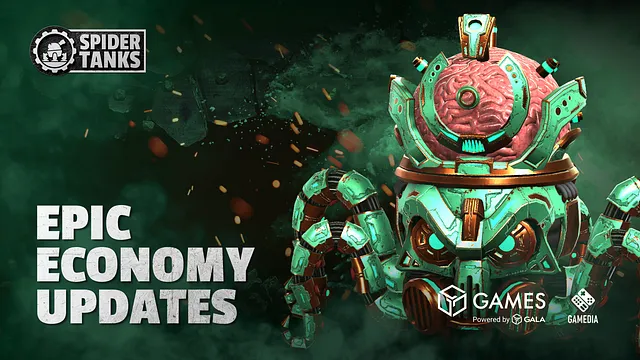Some big changes are coming to Spider Tanks in the near future. Today, we’ll break down everything you need to know.
We’re coming up on half a year since the PC launch of Spider Tanks, and the arena is still just heating up. The GAMEDIA team has tons of new features and Tank Parts coming soon to an arena near you, but first we have a few changes that we think will be very welcome for every Pilot and Captain out there.
Like real world economies, game economies often involve certain degrees of experimentation to dial in sustainable and productive systems. Though extensive modeling and projections take place prior to enacting ecosystem changes, no one can perfectly predict how economic structures stand up to the test of (often chaotic) real world application.
This is why we always continue to innovate and plan better ways to bolster and optimize the ecosystem of Spider Tanks. As more economic data becomes available, we’re able to fix more specific issues and make better systems for the future of Spider Tanks overall.
Economic Overhaul
While we are very excited for the community to get a chance to interact with these economic changes, it’s important to note that this is only a test. We will be running this system for a short time and will make decisions about its future prospects and changes needed after we’ve analyzed the results from this experiment.
Data isn’t all we’re after on these changes though. We want to hear community feedback about the new system so that we can continue to grow the Spider Tanks ecosystem into something better with each adjustment.
The changes in this experiment have already started being enacted, and have two main components. How the SILK distribution each day is calculated will soon be significantly altered and store prices on Arachnium and Components have already been changed.
Many of you may have already noticed more expensive Components in the store. Don’t get too alarmed! These pricing changes are designed to work alongside the new distribution formula for a more robust rewards system for all players.
SILK Distribution Changes
-How It’s Been-
As laid out in the Spider Tanks Lite Paper, the SILK distribution comes from two separate pools. The Replacement Allowance distributes SILK based on VP gained playing matches each day and the Non-Replacement Allowance distributes SILK based on VP gained via Planetary Nodes or Maps.
The daily VP:SILK ratio of the Non-Replacement Allowance is determined by the circulating supply of SILK versus the soft cap. The daily VP:SILK ratio of the Replacement Allowance is determined by the total SILK burned the previous day.
As SILK burn and circulation only determine the VP:SILK ratio distributed from each of these pools, they can be scaled higher with more participation in the ecosystem to gather more daily VP. Extra VP earned within the ecosystem in a day does not affect the ratio of the distribution, because that rate is entirely determined by burn or supply regardless of how many VP are awarded to players.
Due to the fact that the Replacement Allowance is based directly on the burn from the previous day, the VP:SILK ratio can swing heavily one day to the next for players. In the case of Nodes and Maps, the distribution ratio has been severely limited, because it’s based solely on circulating supply. VP possible within a day is heavily bottlenecked through the Node Queue and Map Queue.
-New Changes-
For this experiment, we’re doing away with the Non-Replacement Allowance and Replacement Allowance pools entirely and combining them into one distribution pool for the entire ecosystem. This new pool will distribute daily to Players, Node Depots, Node operators and Map owners at set proportions.
Rather than isolate daily burn and circulating supply as separate pools, for this test we will use one simpler calculation that includes an algorithmic emission of SILK up to the soft cap. This will mean there’s a lot more SILK to go around, but as there is more SILK in circulation less will be distributed each day.
Daily issuance = 0.25% * (50 million — total SILK in circulation)
Rather than daily burn increasing the next day’s distribution only, now burn will more slowly increase the VP:SILK ratio — cumulative burn matters rather than only prior day burn. Compared to the prior average, this should result in more SILK being distributed throughout the ecosystem daily.
SILK will be distributed daily in the following proportions based on participation the previous day:
- Matches (Captains, Pilots and Owners) — 45%
- Parts deployed in Node Depots — 5%
- Planetary Nodes — 9%
- Founder’s Nodes — 1%
- Maps — 10%
- Gala Games — 15%
- GAMEDIA — 15%
It should be noted that the distribution will consist of a set amount of SILK distributed each day determined by the emission formula, rather than a set VP:SILK ratio determined by burn or supply. This means that within each of the above activities, more Victory Points won in a day by many players could potentially decrease the overall ratio since they are sharing a set amount of SILK.
Burning SILK to buy Arachnium, Components or Tank Parts under this new formula essentially extends the emission schedule. It would decrease the circulating supply, thus increasing how much SILK is distributed on a given day.
Component and Arachnium Pricing
As many of you have seen in the past few days, Component and Arachnium prices in the Spider Tanks Store have changed. These prices were originally pegged to SILK. Now that we’re testing this new algorithmic emission model, this needed to change.
These prices have now been pegged to the US Dollar wherever they were previously pegged to SILK. The store price will adjust regularly to accommodate this price in SILK, just as other areas of the store do for GALA or ETH.
While these may initially seem like large increases in the cost of upgrading Tanks, it will be offset by a larger amount of SILK distributed through the daily emission. Higher SILK burn in the store for Arachnium and Components extends the emission schedule, resulting in a higher and more stable distribution.
It’s important to note again that under this new system, more overall VP in a given distribution group during a day divides the total distribution wider, potentially reducing the ratio. As Generation 2 Tanks and beyond become the norm, it will be more difficult for players to acquire level 30 Tank Parts. This is by design, and creating a system where it is too fast and easy to upgrade Tanks should be avoided. Overall, both the adjustments together should balance out quite well.
Supercharge price will be adjusted as well to keep it proportionally similar to the rewards it offers now. Drop Pod prices were also changed to a USD peg, but were greatly reduced relative to their previous SILK cost.
Start Your Engines
This test will begin very soon, and we’ll keep you updated on the results and our future plans as we see this experiment play out. There’s some awesome new content coming to the arena before too long that we can’t wait to reveal as well, so stay tuned!
This arena was made for all of you. We above all want Spider Tanks to be a challenging and fun experience. If you have feedback or questions about this economic test, feel free to shout them out in the comments below or come see us on Discord!





